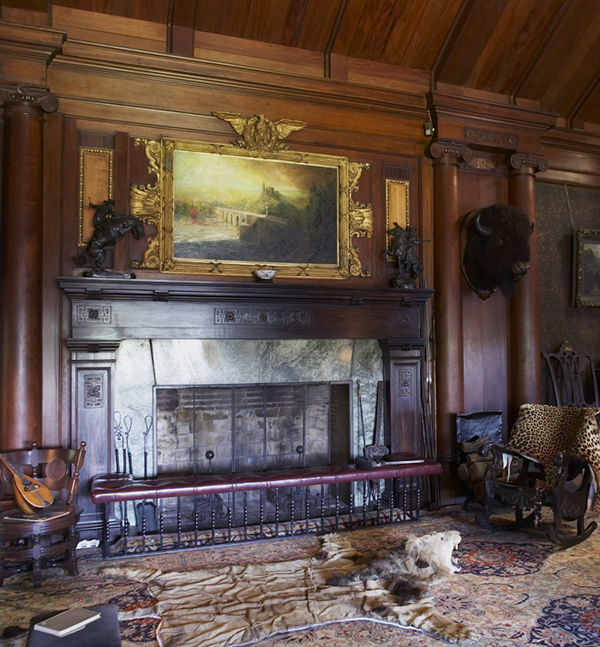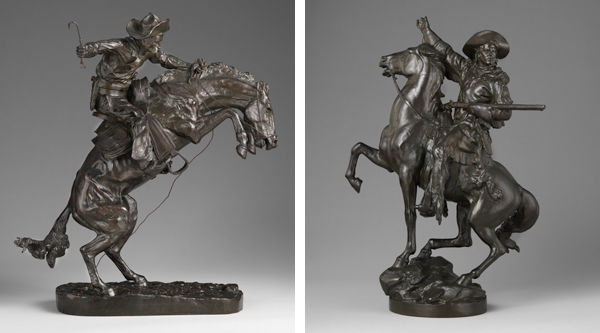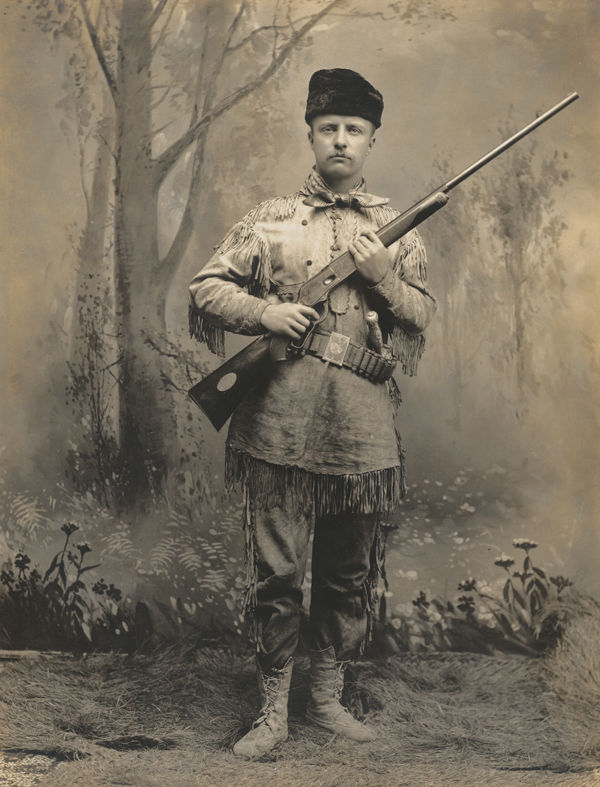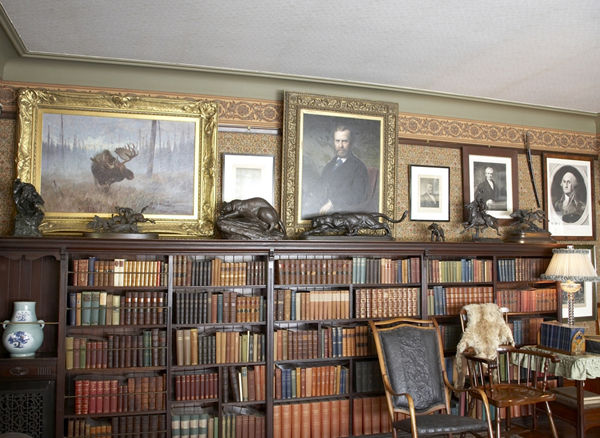
View of fireplace in the North Room at Sagamore Hill National Historic Site with Frederic Remington's The Broncho Buster (left) and Frederick William MacMonnies's Kit Carson (right). Photograph courtesy of the National Park Service
Led by Lieutenant Colonel Theodore Roosevelt, the First United States Volunteer Calvary, better known as the Rough Riders, was a rag-tag group of cowboys, ranchers, American Indians, and college athletes recruited to fight in the Spanish-American War. Participating in the Battle of Las Guásimas, the Battle of San Juan Hill, and the Siege of Santiago, the troop helped bring the war to a victorious close, returning home from Cuba on August 14, 1898. In honor of Roosevelt's leadership and service, the Rough Riders presented him with a cast of Frederic Remington's The Broncho Buster (currently on display in The American West in Bronze, 1850–1925). Upon receiving the statuette, Roosevelt said to his to men, "To have such a gift come from this peculiarly American regiment touches me more than I can say. This is something I shall hand down to my children, and I shall value it more than I do the weapons I carried through the campaign."

Left: Frederic Remington (American, 1861–1909). The Broncho Buster, 1895 (cast by 1898). Bronze, 23 3/4 x 21 1/8 x 11 7/8 in. (60.3 x 53.7 x 30.2 cm). Sagamore Hill National Historic Site, Oyster Bay, New York (SAHI-918). Right: Frederick William MacMonnies (American, 1863–1937). Kit Carson, ca. 1907–11 (cast by 1915). Bronze, 25 1/8 x 16 3/4 x 10 3/8 in. (63.8 x 42.5 x 26.4 cm). Sagamore Hill National Historic Site, Oyster Bay, New York (SAHI-919)
Roosevelt proudly displayed the work over the fireplace in the North Room at Sagamore Hill in Oyster Bay, New York, his home from 1885 until his death in 1919. Amy Verone, Park Curator at Sagamore Hill National Historic Site, noted that the North Room was "the Roosevelts' favorite room. It was where they spent their evenings, and The Broncho Buster was easily visible from where T.R. liked to sit. He admired the work from a sculptural standpoint, but it was also a sentimental reminder of the time he spent with the Rough Riders." Remington's dynamic depiction of a cowboy breaking a wild horse also embodied Roosevelt's vision of the westerner, whom he praised as a hardworking, self-reliant American hero. His impressions were informed by his time spent in the West: in 1883, Roosevelt traveled to Dakota Territory to hunt bison, purchasing a ranch in the Badlands before returning east. The following year, after the passing of both his mother and his first wife, Alice Hathaway Lee, Roosevelt sought solitude in the West, returning to Dakota Territory where he built his second ranch, the Elkhorn.

Theodore Roosevelt in Buckskins, Dakota Territory, ca. 1885. Roosevelt R500. R67, Theodore Roosevelt Collection, Houghton Library, Harvard University, Cambridge, Massachusetts
"T.R. quickly became entranced by life on the prairie," Amy explained, "and in the 1880s, he began publishing written accounts of his experiences out west in popular monthly magazines such as Scribner's and Century." His articles were often accompanied by the illustrations of an up-and-coming western art star, Frederic Remington. Roosevelt's interest in art was informed by childhood experiences: at the age of ten, he traveled to Europe with his family, visiting the museums and monuments of London, Paris, and Vienna. Roosevelt's parents also collected art, displaying bronze statuettes in his childhood home, and his father, Theodore Roosevelt Sr., helped found The Metropolitan Museum of Art.
When Roosevelt was in his junior year at Harvard, he purchased his first artwork, spending two hundred and fifty dollars at Tiffany & Co. to acquire a bronze cast of James E. Kelly's Sheridan's Ride (1879) (the second sculpture on the right in the photograph below). Roosevelt continued to collect sculptures throughout his lifetime; as Amy noted, "T.R. was partial to bronzes, and we have nearly thirty in the collection. He was primarily interested in representational art, and the sculptures visible in historic photographs of his house are almost always western themed."

View of sculptures in Theodore Roosevelt library at Sagamore Hill National Historic Site. Photograph courtesy of the National Park Service
Through both gifts and purchases, Roosevelt patronized many of the artists featured in The American West in Bronze, 1850–1925, including Edwin Willard Deming, Edward Kemeys, Frederick William MacMonnies, Alexander Phimister Proctor, and Charles Russell. He prominently displayed Kemeys's Jaguar (ca. 1885) and Proctor's Stalking Panther (1891–93) in his library at Sagamore Hill. He also bought a cast of MacMonnies's Kit Carson (ca. 1907–11) from Tiffany & Co. in March 1915—an "un-birthday present" to himself, as his second wife Edith Roosevelt described it. He placed Kit Carson (currently on display in the exhibition) on the North Room mantel alongside Remington's The Broncho Buster, and together these sculptures encapsulate his heroic conception of the American West.
"T.R. didn't purchase artworks to impress his friends or his neighbors, and he wasn't necessarily interested in creating a collection," Amy explained. "He would acquire a work simply because he liked it, and he often bought sculptures and paintings as souvenirs of his travels or to commemorate an important moment in his life," she said. His preference for western-themed works, and specifically animal subjects, is evidenced by his bold move as President of the United States to replace the lion heads that decorated the limestone mantel in the White House State Dining Room with two North American bison heads, completed by Proctor in 1909. Roosevelt also encouraged members of the American Institute of Architects to abandon the lion for the bison, "a beast," he wrote, "which equally lends itself to decorative use and which possesses the advantage of being our own."
After Roosevelt's death in 1919, Proctor memorialized the twenty-sixth President in a monumental bronze equestrian statue Theodore Roosevelt, Rough Rider, donated to the City of Portland, Oregon, in 1922. The casting of this sculpture in bronze was documented in a 1922 silent film that is included in the exhibition (and also embedded in one of my earlier posts, "Cast in Bronze," December 31, 2013).